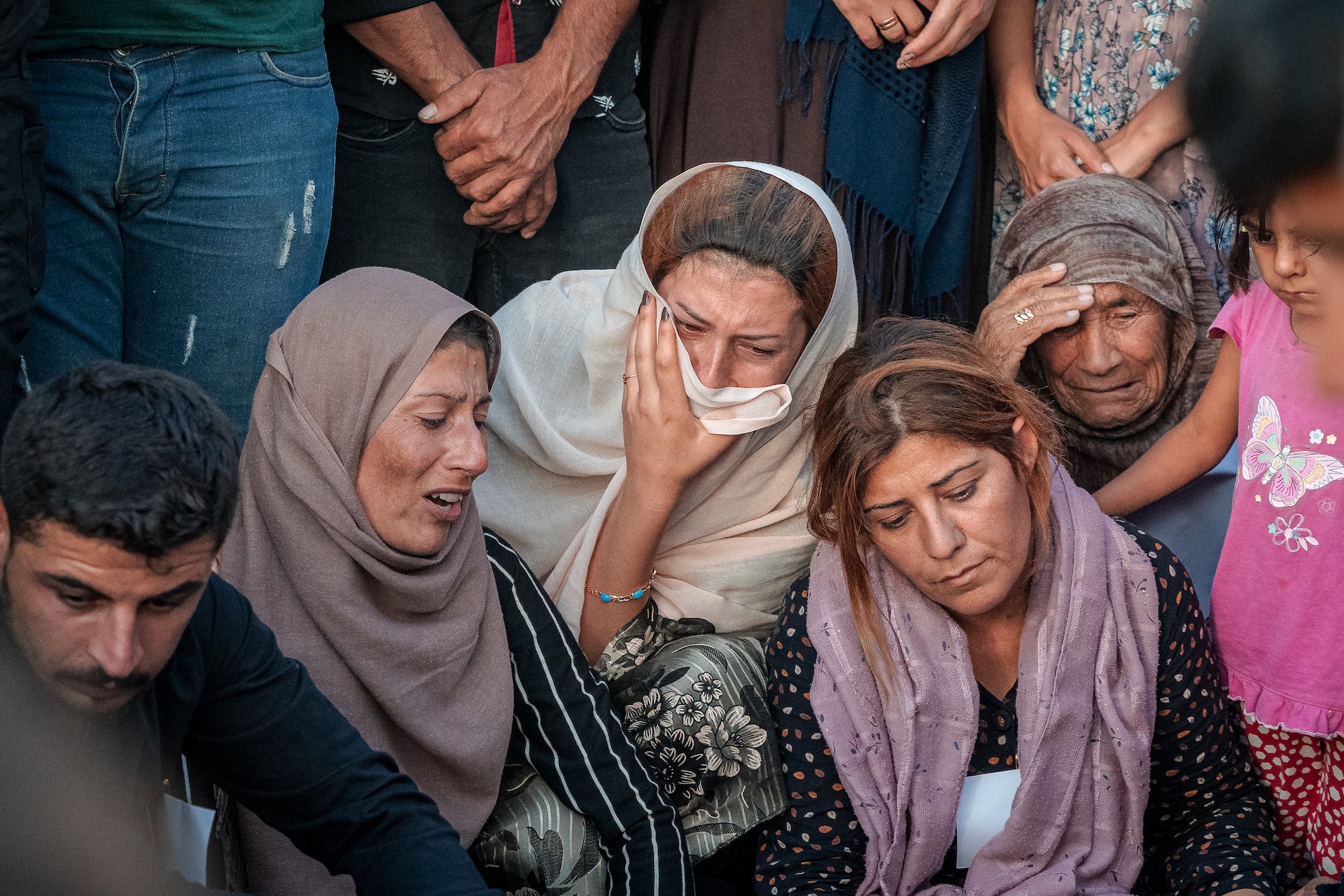
Women at a funeral in Kobani mourn an SDF soldier who died in June after an ISIS sleeper cell attack in Deir ez-Zor. Photo courtesy of Clandestine Media Group.
Three heavy circle bolts hang from the ceiling in a dark basement, at the end of a long hallway, under the municipal soccer stadium here. The rope bindings cut short and frayed have turned brown with blood and age. This execution room used by the Islamic State of Iraq and Syria during its three-year reign of this ancient city saw untold horrors. Tortures. Rapes. Beheadings. Now it is an empty shell, a memory of violence with broken and blown-out walls, stained ropes, rusted chains; there’s a lone plastic sandal caked in dust in one corner and a faint smell of bleach.
By one account, 2,000 prisoners were executed here. Locals called it “The Black Stadium” because of its dark stone construction. Under ISIS, the name felt all the more fitting. Yazidi women were sold as sex slaves to ISIS emirs on the stadium field above. At Na’eem Square, not far away, wrought-iron fence posts were used as pikes to display decapitated heads. The stadium track is cut with the heavy scars of tank treads and the cometlike marks of trailing small-arms fire. There is no stone wall or surface anywhere untouched by gunfire. Three days into our two-week-long road trip across this war-torn country, we entered this city of 300,000, the sixth-largest in Syria, and the self-proclaimed capital of the ISIS caliphate during its reign from 2014 to 2017, before Syrian Democratic Forces (SDF) on the ground and US air power in the sky took it back.
A poster for an upcoming soccer match taped near the stadium entrance is a small sign things have changed. Hurdles down the track are pushed off and half-stacked to one side — like hurdles before a high school track meet anywhere. There is a small stone monument to the martyrs who gave their life in the Battle of Raqqa, but outside that — aboveground — it looks like an old football stadium anywhere in the developing world, worn out, but ready for play.
This recovery, what has become an island of democracy in hostile, violent seas, is the greatest untold story in the modern history of the Middle East. The people of Syria have survived wars and occupations and untold violence, leaving hundreds of thousands dead and twice that wounded or grieving. They live in the face of rocket attacks, terrorists, and a threatened invasion by the second-largest army in NATO. Yet despite it all, they’re practicing democracy with a new government they call the Autonomous Administration of North and East Syria, or the AANES. Without the world watching, these resilient people, who occupy territory that covers a third of Syria proper, are practicing democracy.
“It’s a permissive environment,” said Brandon Wheeler, CEO of Freedom Research Foundation, a US nonprofit, who’s worked in Syria since 2006. “You have to be situationally aware. You have to be smart. But it’s not a war zone,” he said of north and east Syria under the AANES.
“The people here want stability, and they’re doing it. Democracy has to be a behavior before it can be a form of government.”

A room under the soccer stadium in Raqqa that ISIS used to torture and execute prisoners. Chain bindings still hang from the ceiling. Photo courtesy of Clandestine Media Group.
Under the stadium in Raqqa is a violent memory of how far things above the ground have come. Wheeler and his team helped secure interviews and access to these places to see firsthand what northeast Syria was, and what it is fast becoming. Below ground here there is a long, curved hallway that runs the length and shape of the track above. Rooms break off every few meters. ISIS graffiti is still everywhere. When the SDF took the city in 2017, some wanted to scrub all signs of barbarity from the stadium. Abu Omar al-Idlibi, the SDF commander of the Northern Forces and a member of the Raqqa Military Council, told them to leave it all alone.
“These walls have memory,” he told me. The cement blocks they had taken up from the prison below were buried like human dead. The very infrastructure of Raqqa was tortured, he said, so they honored it for the sacrifice. The blocks not moved were left as they lay — a memorial to the horror, so they may stand in remembrance of the horror, much as Auschwitz and Dachau still stand so we collectively never forget.
A reminder, too, Abu Omar told me later, “that we won.” Over one door, some ISIS fighter wrote “interrogations” in Arabic. The next door is marked “break room.” You can imagine the Tunisian torturers — as several firsthand accounts describe them — cleaning their hands, then walking a few steps away to lie on a mattress and drink tea. Most of these rooms have sledgehammered holes through the walls connecting them, so fighters could change positions without using the main hall. In one spot, ISIS had clearly once posted a machine gun — a window knocked out at a corner, then through two more walls, that opened coverage on 100 meters of hallway. Midway down, the cellblocks start: 3 feet wide, 6 or 7 feet long, made of poured concrete and plaster. I step inside one and turn on my phone’s flashlight. Top to bottom it’s covered in pen drawings and fingernail etchings. Hieroglyphics left by prisoners in fear, marking day counts and cutting prayers into the wall. Someone drew a cell phone battery icon. Above it, at full charge, it reads, “My morale, day one.” There are three more icons of the battery steadily losing power. In the last one, the battery is dead. The message there reads, “Two months in.” Another in English reads, “If you have nothing to lose you have nothing lose.”
“This was an execution room,” says our guide, Ahmad Hilal, a translator and journalist, who now works with Abu Omar’s Northern Forces. A cut ratchet strap hangs from one of the bolts in the ceiling. The walls were painted in some kind of slick industrial coating — the kind of finish that makes for an easier hose down. Hilal himself was a prisoner of ISIS, held in a jail in the northwest. “In a room this size,” he tells us, as we stand in a space maybe 10 meters long by 10 meters wide, “they kept 60 of us.”
I ask him how it feels to be back in a place like this, where he was sent for recording a protest, where he — at 19 years old — experienced brutality most can’t even imagine.
“It feels good,” he says, surprising me. “The people who did this, they are all dead, and I am here. I am alive. I am free. We are all free now.”
Most Americans have written off Syria as another forever war — another Afghanistan that can’t possibly end well. Really, it’s a forgotten war, as international attention has turned to Ukraine, as the global powers backing the Syria conflict have settled into a kind of stalemate. Russia, Turkey, and Israel are still operating active air campaigns — each opposed to the other and with different endgames in mind. The United States’ mission to shut down Islamic State militants, Operation Inherent Resolve, is still ongoing with about 800 troops on the ground. The US partner force, the SDF, engages ISIS sympathizers and sleeper cells almost daily. Meanwhile, Turkey actively hunts SDF and the democratic political leadership through a targeted drone campaign.
"The US partner force, the SDF, engages ISIS sympathizers and sleeper cells almost daily."
We saw this all firsthand. After we crossed the border into Syria from northern Iraq, we stopped in Qamishli for lunch. A few days later, the market in Qamishli not far from where we ate was destroyed by Turkish drones, wounding four civilians. SDF Commander-in-Chief Mazloum Abdi said that during an eight-day period in July, Turkish drones killed nine SDF fighters, four police officers, and 13 civilians. In June, Turkey launched 1,360 attacks on democratic regions in north and east Syria, leaving more than 60 dead. In July, US ally and deputy commander of the SDF, Salwa Yusuk — a legend in the region for the heroics of herself and her all-female unit in the long campaign against ISIS — was killed near Qamishli by a Turkish drone. At the time of her death, a US military official said, “There is no doubt she saved American lives on the battlefield.”
This is something of a head-scratcher.
How does a NATO member country (Turkey) get to target and kill the partner force of another NATO country, the United States? In country, you hear the answer any time a difficult question is asked, whether it be about the global political order or an odd smell in the street. Usually it is preceded by a sigh or a drag on a cigarette or a slumping of shoulders. The answer is always the same: “This is Syria.”
Qamishli is a small city in northeast Syria on the Turkish border, about a two-hour drive from Iraq. It is the historic urban center of Kurdish and Assyrian ethnic groups. ISIS did not take it during its rampage through the Middle East, so Qamishli doesn’t have the shelled-out buildings or broken highway overpasses dangling over nothing common to many other cities in the region. We pull into a perfectly normal-looking office building and guesthouse to sit down with the de facto leader of the AANES, its co-chair, Badran Chiya Kurd.
Badran, who, like every official I meet in the region, does not use his birth name out of security concerns, is a senior executive leader within the AANES. I thought of him as being like the region’s president, but Badran is quick to tell me there is no single executive leadership role here. He’s a big man with wide features and close-cropped hair, wearing a button-down shirt tucked into khakis — the informal uniform of secular government officials everywhere. He’s quick to smile and generous with his time, but his eyes look tired. He looks very, very tired.
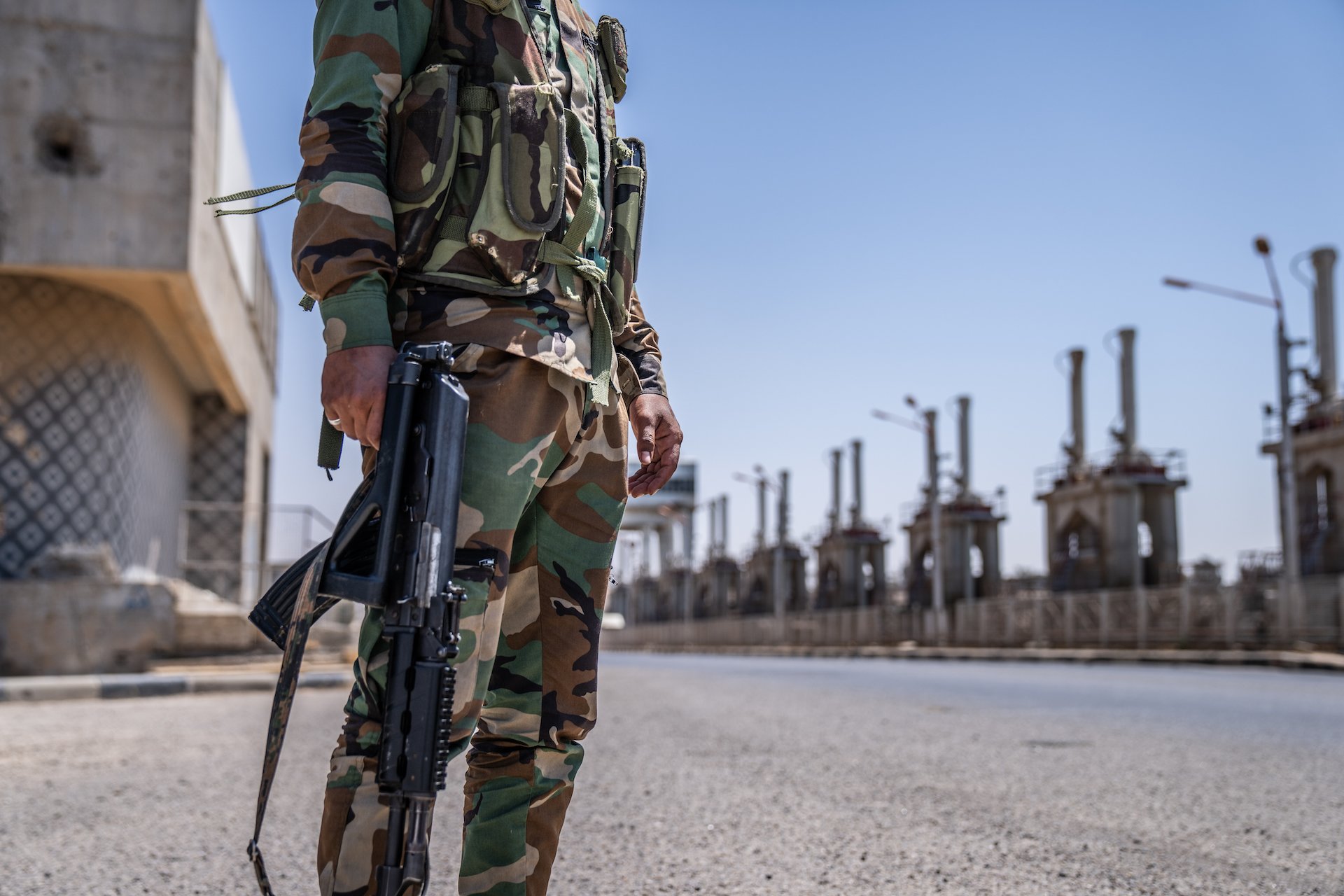
A Syrian Democratic Forces soldier guards the road over Tabqa Dam near Raqqa. The SDF won a ferocious battle against ISIS here in 2017. Photo courtesy of Clandestine Media Group.
“Nineteenth of July 2012, we call this the day of the Rojava Revolution,” he tells me. “Regions were liberated from the [Assad] regime, beginning with Kobani, followed by Afrin and then Jazira.”
That, as they say, was the day everything changed.
The modern history of Syria, and the seeds of the current civil war, trace directly to Bashar Assad, who has ruled the country since 2000. Assad inherited power from his father, who took control in 1970. In 2011, as part of the broader Arab Spring movement, protesters and armed rebels sought to oust Assad and bring democracy to Syria with mixed results.
World powers flooded the zone. Wealthy Gulf states began to support rebel militias. Russia and Iran came to the aid of the regime. (Moscow, to this day, still largely controls the skies over Syria.) Out of that chaos, ISIS came to power, bolstered by tens of thousands of foreign fighters who went to the region to wage jihad. The televised beheadings captured world attention, and the United States stepped in with Operation Inherent Resolve.
Still, on the ground here, backed by US and coalition air support, the SDF battles ISIS daily. Two soldiers were killed at a checkpoint in Deir ez-Zor — not far from Raqqa — while we visited, but Syria today is not the Syria of 2015 or 2016 when ISIS controlled large swaths of the country. This is thanks to the might of the SDF in partnership with the US, and the AANES civil administration that Badran and others like him have built.
The AANES governs a region of roughly 50,000 square kilometers, or about one-third of the larger Syrian landmass. It is divided into seven self-governing subregions that run along the Turkish border to the north and Iraqi border to the east.
Accurate population estimates are difficult to nail down, but one report in 2018 claimed the AANES governed 2 million people. On the ground, officials say it could be as many as 5 million, as the standard of living is higher within the AANES compared with regime-controlled Syria to the West or Turkish-occupied areas to the north. (An official census project was launched in May 2022 to get real figures.)
Each subregion has its own mix of ethnic groups. Locals will talk of places like Raqqa as an “Arab area” or Kobani as a “Kurdish city” to note the dominant ethnic/political presence in a region, but across the greater AANES the majority population is Arab (or Arabized peoples who use Arabic as their first language) followed by Kurds, Assyrians, Turkmens, and a mix of smaller minority groups including Yazidis, Armenians, and Chechens. Sunni Islam is the most widely practiced religion, but that itself subdivides into many sects. Plus, there are various brands of Christianity and other indigenous religious practices in the mix.
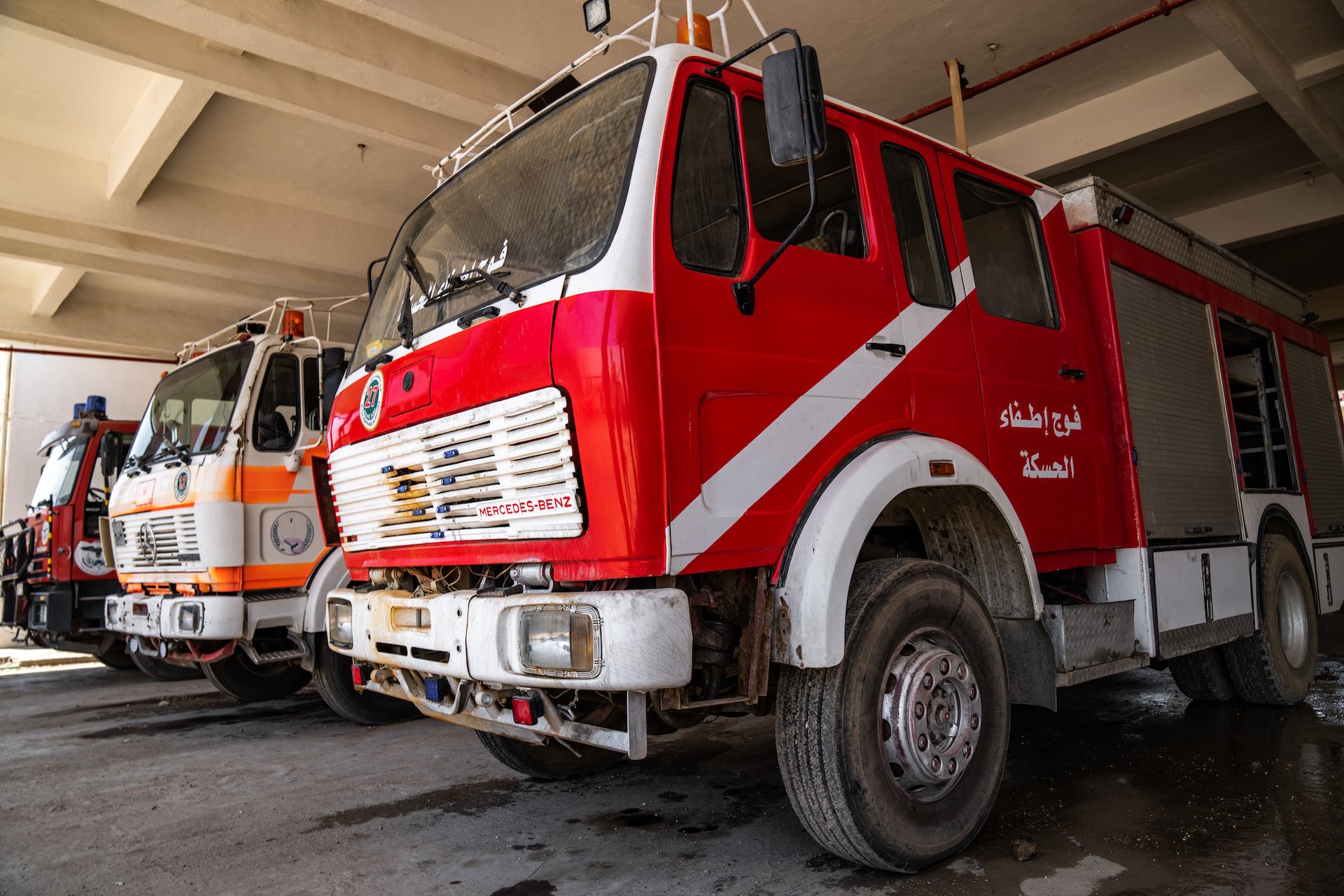
Firetrucks in waiting at a Civil Defense station in Hasakah. Photo courtesy of Clandestine Media Group.
All told, the region is a complicated tapestry of ethnicities and religions, tribal and political affiliations, largely neglected and ungoverned by the Assad regime, then torn apart and brutalized by the Islamic State and other fundamentalist groups.
“Since 2011, when the crisis began in Syria, the people of the region organized themselves to protect their communities,” Badran says. “We focused on self-defense. We wanted to protect our region. We established our local councils, and we built our local institutions.
“We managed to kick out the institutions of the [Assad] regime — the service institutions, the military institutions — and on the 19th of July 2012, we call this the day of the Rojava Revolution, regions were liberated.”
(Rojava, pronounced ROH-zhe-vuh, is the historic name of the largely Kurdish regions of Syria.)
By the end of 2013, the Autonomous Administrations of Kobani, Jazira, and Afrin were declared. These were the first three and in largely Kurdish-populated areas. Through late 2013 and early 2014, leaders of these communities drafted what they call the Social Contract “to document the principles upon which the Autonomous Administration should rule the region,” Badran tells me.
The Social Contract is essentially the Bill of Rights for this new Syria.
“Kurds, Arabs, Syriac Christians, Armenians, Turkmen, and all the sects of Islam, Christian, and Yazidi in the region helped write it,” Badran says. “Everyone was granted rights and the freedom of expressing their religious identity, their ethnic identity, and the freedom to language and culture — to live in peaceful coexistence with each other.”
A framework of regional governance was established that every American with a middle school civics class under their belt can understand:
- a Legislative Council, like a parliament, for the creation and writing of laws;
- an Executive Council, or the executor of those laws;
- and a Justice Council, the judiciary system.
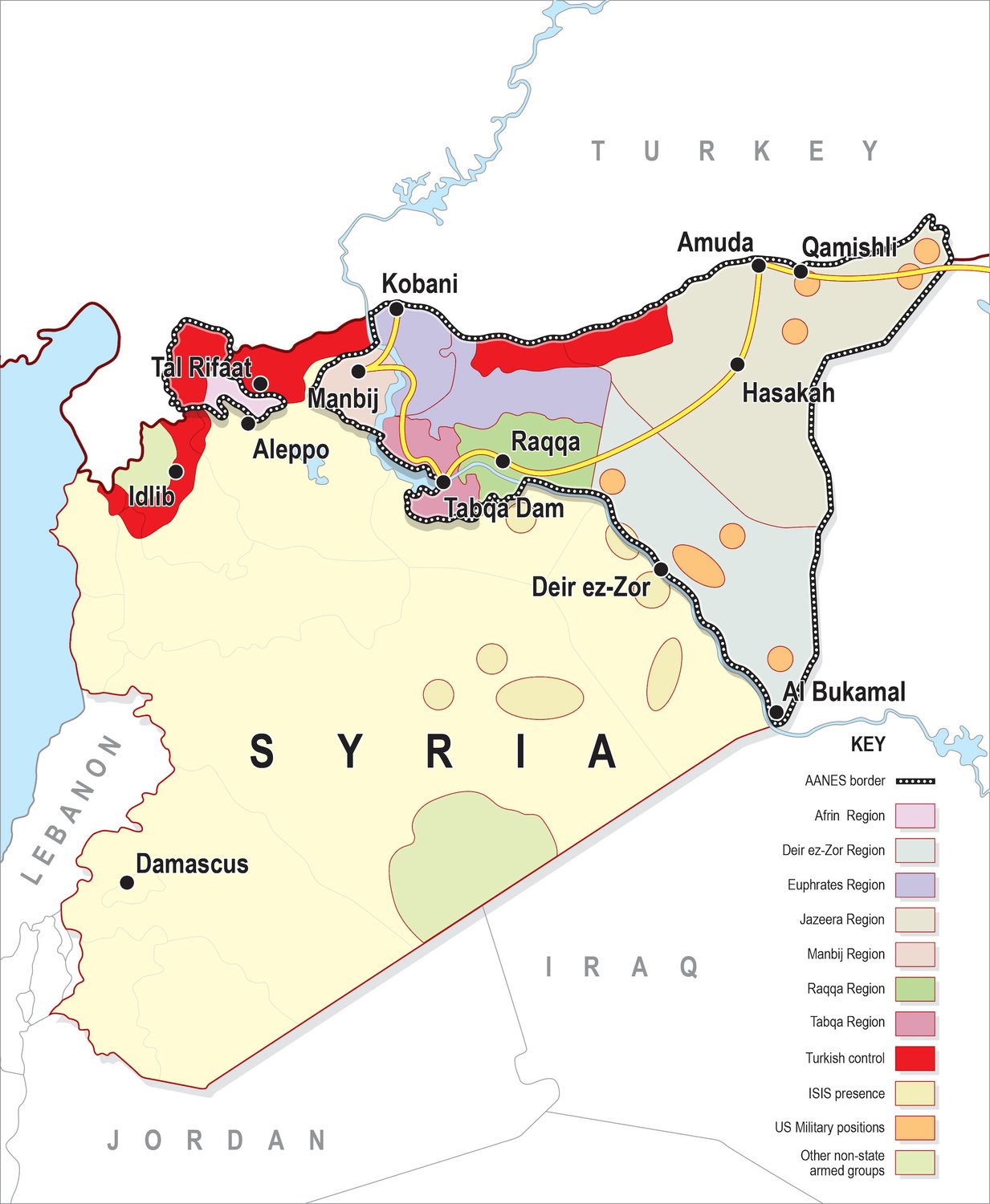
The Autonomous Administration of North and East Syria, or AANES, is an island of democracy in the hostile waters of Middle East politics. With a hot war underway against ISIS sympathizers and sleeper cells, plus a threatened invasion by the second-largest army in NATO, Turkey, many are wondering how long the free people of the AANES can hold on. The author and a team from the nonprofit Freedom Research Foundation traveled overland through north and east Syria to ask this question and explore potential solutions. Illustration by Mark Watkinson.
The subregions have their own legislative, executive, and judicial councils; much like in the US, there are federal and state court systems. But Badran and other leaders of the AANES don’t see their government solution as a future independent state but rather as a model for a future federalized Syria, the AANES but one region in a larger federal system.
“We do not aim at building an independent state here,” Badran tells me. “We are an integral part of Syria. We would like our model of governance to be implemented for all of Syria — a model for the future of Syria, a solution for the Syrian crisis.”
All the councils are run by committees, each with two co-chairs — one a man, the other a woman. “This is the unique aspect of our revolution,” Badran says. “Gender equality is foundational — equal and effective participation of women in all aspects of government, including the military.”
In 2018, the AANES was officially declared.
Two early victories in civil administration have been achieved in education and health care.
“Every region has its own characteristics, so every region has its own educational curriculum,” Badran tells me. “For example, in Jazira, we have a curriculum that is taught in three languages: Kurdish, Arabic, and Aramaic, the language of Syriac Christians. Arabs study in Arabic, Kurds in Kurdish. This is one of the principles of the AANES: that every child has the right to learn his or her mother tongue.”
He says 900,000 students study according to the curriculum of their region, about half girls, with tens of thousands of teachers across north and east Syria who teach in accordance with the Autonomous Administration curriculum.
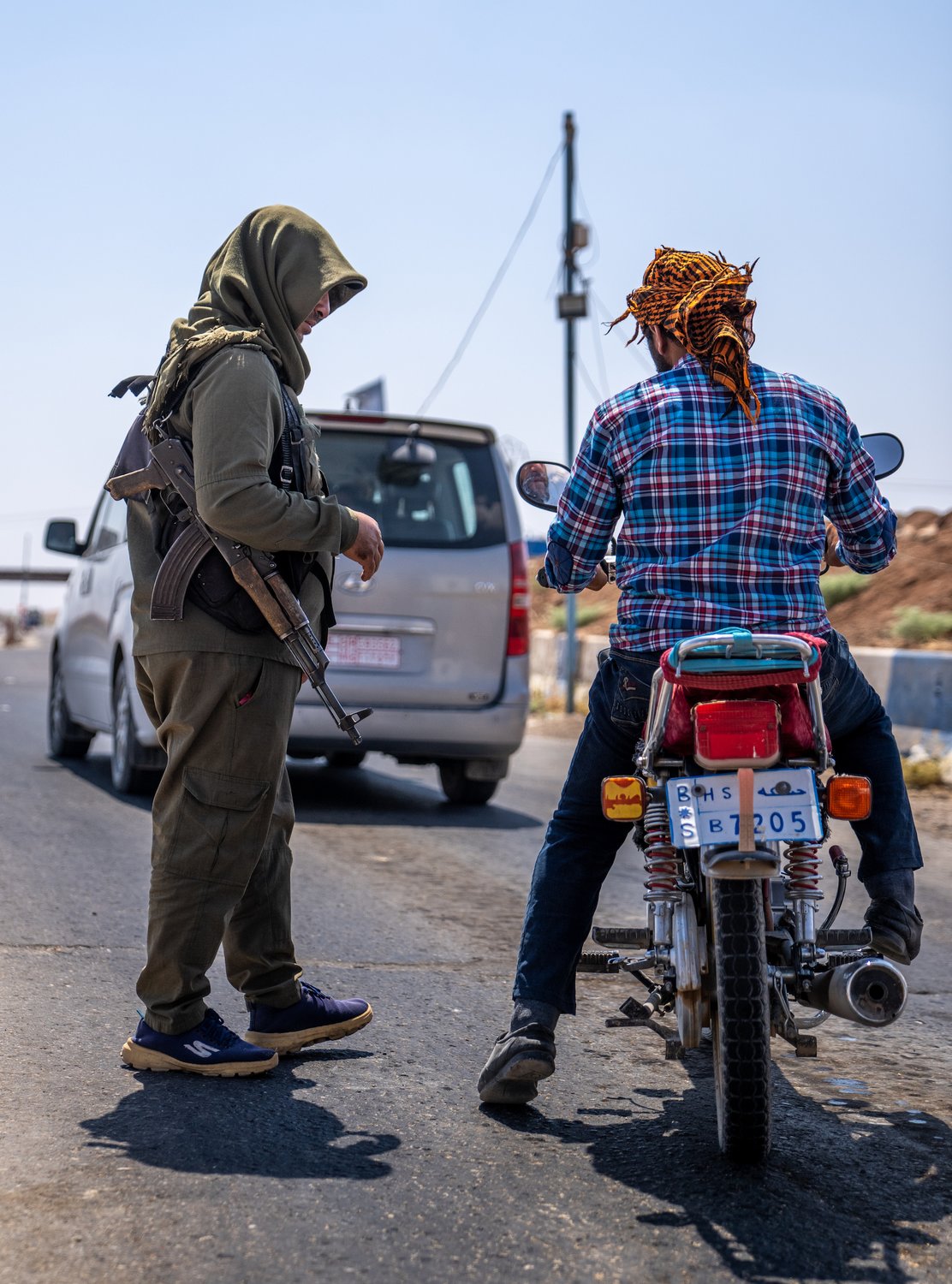
Scenes from the road: a routine paper check. Photo courtesy of Clandestine Media Group.
The administration has built health centers in almost every region in what is effectively free and universal health care. With limited supplies due to closed borders (and until very recently, international sanctions), they’re hardly modern facilities by Western standards, but there is an infrastructure of buildings, established supply lines, and medical staff capable of routine care, from delivering babies to treating trauma from car accidents, fires, and myriad other injuries.
“Historically, the democratic experience in the Middle East has not been encouraging,” Badran tells me. “It has not been good. The political systems in the Middle East have long been oppressive and tyrannical, denying the rights of the other, marginalizing freedom. We are aiming to avoid this.”
Northeast Syria looks like Southern California — amber rolling hills punctuated by palm trees, blacktop roads radiating heat like mirage in a riflescope. As we push south out of Qamishli toward Hasakah, that lush, tropical landscape begins to change — gradually flatter, gradually drier, gradually hotter.
In time, only the hot blacktop remains the same. The landscape becomes the Syria of the American imagination: dry sand, hard sand, a Flat Dark Earth horizon. From the back of our Land Cruiser, the arid khaki landscape of dunes and dust storms changes incrementally into low stone walls of dirt pastures and sheep. Mud huts with corrugated metal roofs pop up deep on the horizon, then closer and closer to the road, appearing with more regularity. The walls grow taller and traffic picks up. Soon we are in a city, Hasakah.
Motorcyclists with three, four, even six riders buzz our Toyota. A pickup truck loaded with vegetables blares sale prices through megaphone speakers that rattle the windows. Our driver brakes for no one, cuts wide into oncoming traffic, then around back into our lane. He brakes like only third-world and New York City drivers brake — throwing the lot of us in the back up against the front seat and each other. Women in black niqabs shoot daggers at our cameraman in the front seat whenever he leans out for a photo. I’m struck by how much the eyes can convey when they are all you can see of a person’s face. The driver banks hard right and we brace in the back, then stop. We’re at the municipal fire department — a few of us are green with carsickness.
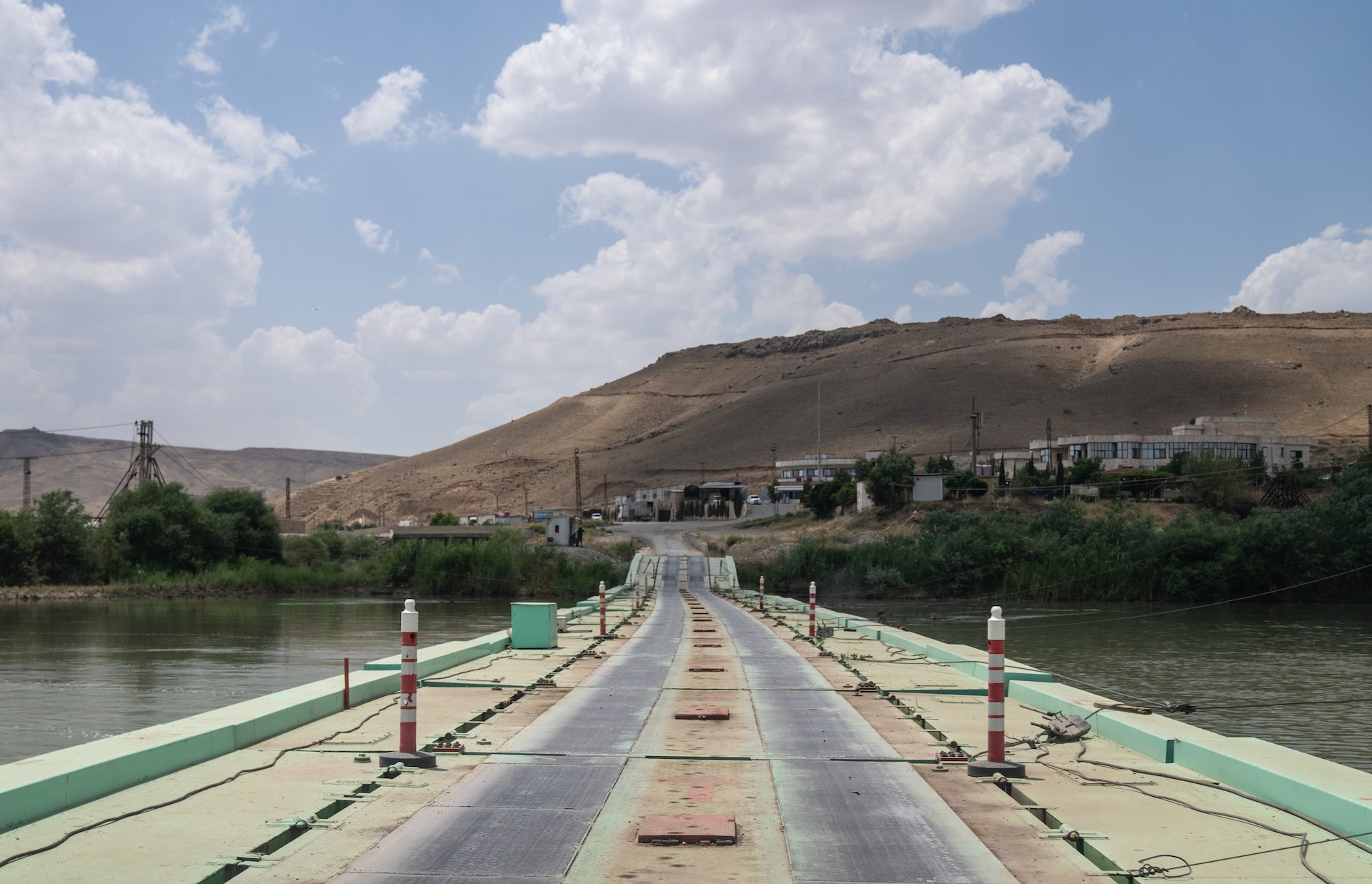
Scenes from the road: a routine paper check, the bridge over the Tigris from Iraq into Syria. Photo courtesy of Clandestine Media Group.
Abraham Hussein has directed firefighter training in Hasakah for six years. There are 76 firetrucks, most of them dating to the 1970s and 1980s, across the Jazira region, including 13 here at Hasakah, parked in a neat row under a sun cover. The firefighters take 40 to 60 calls a month. This summer, the dive unit has been particularly busy, pulling drowning victims out of the nearby Euphrates. “Any survivors?” I ask.
“No,” he says. “Never. By the time the dive unit gets there, it’s always too late. Four so far this summer.”
“It’s a recovery for the families,” I add.
“For the families,” he replies.
Their biggest concern — like pretty much every fire department on the planet — is funding. But this is Syria, and with the cost of war and food, essential gear like respirators can seem a luxury. One of the first responders sitting around the table with us, I notice, has a deep and angry cough.
“The trucks are old. So are the uniforms,” Hussein says. “We wish we could get [new gear] to feel safer, to better the civil defense of our area, but now we get by.”
The biggest risk to the firefighters are the large agriculture fires that can take over acres of wheat at a run. They can be thought of like prairie fires in the American West. “Some NGOs are helping, particularly with bringing foam fire retardants to our crews,” Hussein tells me. Drought in the area has made the situation all the worse, as have water levels on the Euphrates. Turkey controls the river flow, and AANES officials claim the country has restricted the flow against international water law.
“I did not steal a tank. It was the people’s tank.”
We see it ourselves when we stop at Tabqa Dam, site of a monstrous battle between the SDF and ISIS in 2017. The Euphrates indeed looks thin, no longer a river of biblical proportions that baby Moses floated upon, but more like a deep-cut canal with wetlands sprawling off it. The water level is so low that no turbines are running the day we visit.
From here we pull into Raqqa, to meet with Abu Omar, commander of the Northern Forces. He is tall, over 6 feet, with slicked-back hair, dressed in fatigues — a digital camo pattern that’s favored, it seems, among the higher-ups.
Abu Omar got his start at the very beginning of the civil war in 2011 when he was conscripted into a tank battalion in Assad’s army. He defected from the regime with his tank and used it against them. When I meet him at his compound in Raqqa that houses 400 families, most displaced from Idlib by the threat of violence from the Assad regime and Turkish-backed militias, it’s the first thing I mention. “I hear you stole a tank.”
“I did not steal a tank,” he says matter-of-factly, clearly annoyed. “It was the people’s tank.”
“So you liberated the tank,” I say.
Yes, he agrees. He says it in English with a smile: “Liberated.”
I ask him how he got shells for it, and he tells me he bought them from the regime.
“The same regime you were using the tank against?”
He shrugs as if to say, Everything is for sale in Syria.
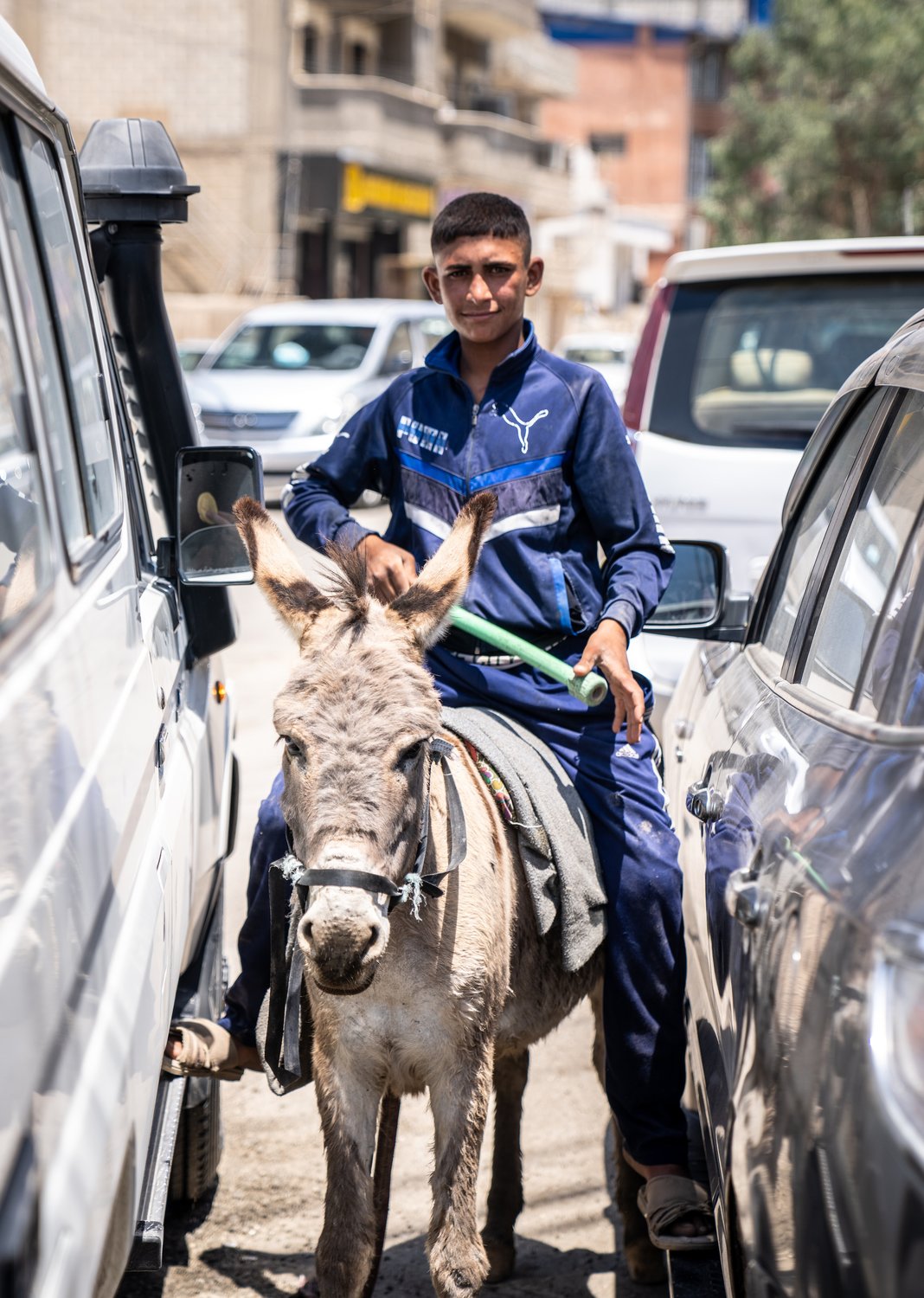
Scenes from the road: a street kid with a donkey. Photo courtesy of Clandestine Media Group.
In time, his men liberated more tanks until they had their own small battalion. He has brought his forces to Raqqa twice since 2011 — once, he says, “to work the city free from the Syrian regime, and a second time to defeat ISIS.”
We walk his base — more or less a large neighborhood block surrounded by a blast wall. Every building has been kissed by gunfire. Many look like rubble, bombed out, deserted, if not for a blue tarp hemming in one side of a crumbling balcony, or laundry hanging on another, drying in the sun.
Abu Omar stops and points. “Most of the ISIS leaders were living here in this house,” he says. The houses were the hardest to clear, he says, because ISIS men armed their wives and children.
And before ISIS, the Mukhabarat, Assad’s Military Intelligence Service, occupied the buildings. “Many have suffered and lost their lives in these buildings,” he says.
When ISIS fighters retreated, they left improvised explosive devices behind. Everywhere through Raqqa are spray-painted triangles, on entryways, streets, and sidewalks, marking a cleared area that bomb crews have swept for hidden explosives.
Abu Omar stops on sidewalks and street corners to recount the spots where he’s lost men.
“Here,” he says, stopping our tour in the middle of a four-lane street with a heavy concrete divider. “There was a sniper on those buildings there” — he points 200 meters east — “and he shot and took two soldiers from us here.”
He takes us by a pile of jumbled and mutilated vehicles stacked around a 3-by-3-meter hole in the earth. This was a VBIED factory, where ISIS made car bombs. When coalition air support hit it, the explosion could be seen for miles. It left this impressive crater and a spaghetti salad of car frames. “In this area we lost 70 soldiers here, killed by ISIS,” he says. “In this compound area. It took one month to take it from them.”
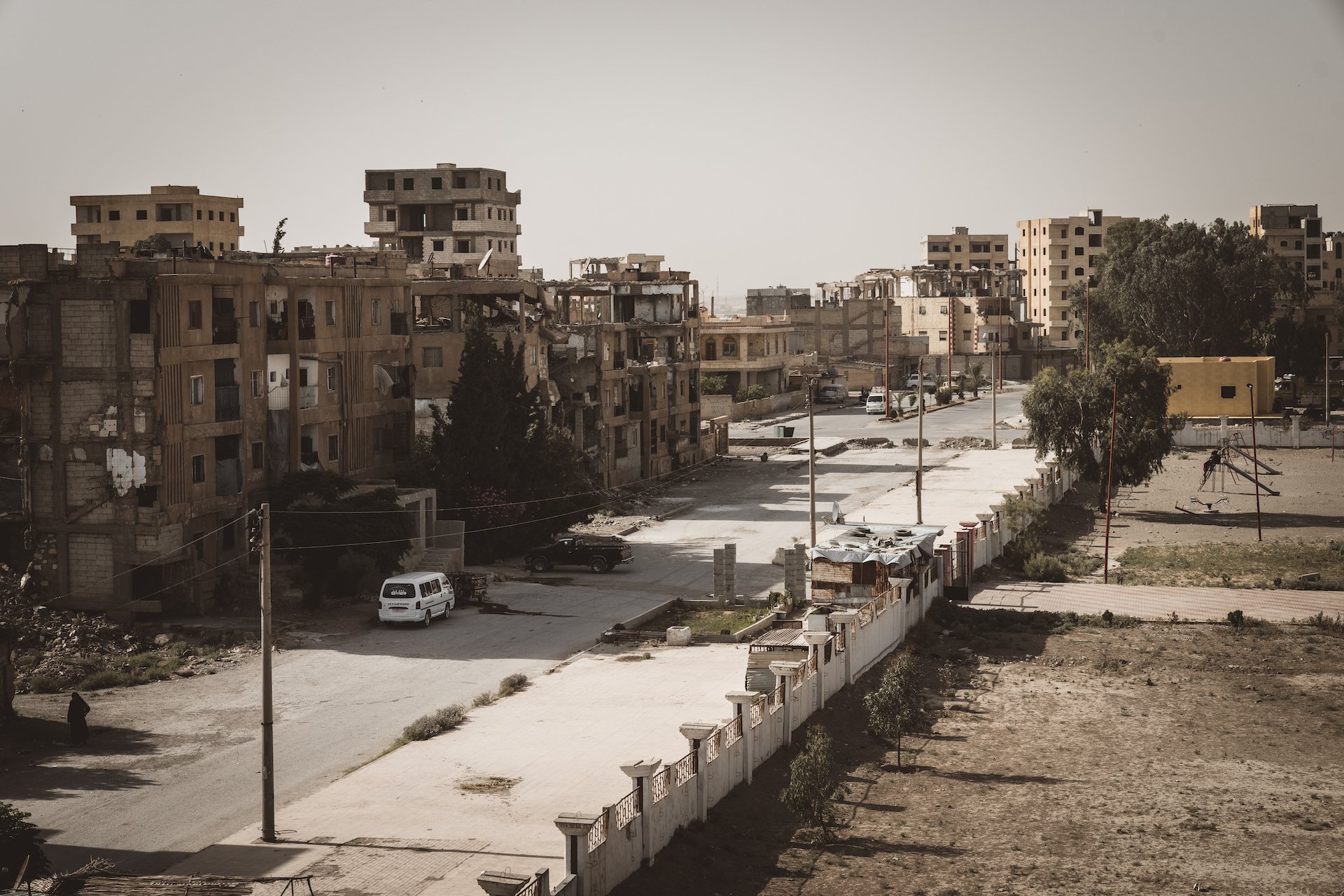
This Raqqa streetscape is typical of Syria: light traffic and bombed-out buildings. Photo courtesy of Clandestine Media Group.
In this new democratic Syria, Abu Omar is effectively the military commander for the regional Northern Forces, connected to the regional government, in this case the Green Idlib Community Council, which is also in exile and existing under care of the AANES. The council funds day care and schooling for children, plus a women’s center that is working to help victims of domestic and sexual violence.
We round a corner back near the buildings where ISIS emirs directed the defense, and loss, of Raqqa. Behind them is a courtyard and fenced-in soccer field. Forty or 50 children are running balls around cones and taking shots on goal. They stop and stare when our party of pale faces gets to the fence. Then we put up a drone for photos and soon they’re chasing, screaming, mugging for photos in a stream of chatter and smiles.
Raqqa and most of Syria within the AANES seems like this — once a site of torture, where 70 in this case died in combat, now, seven or eight years later, kids run free, laughing and playing on an artificial turf field.
We leave the kids and visit the stadium in Raqqa, then stop for a shawarma lunch before pulling out of town.
A crowd of street kids forms, and after a photograph, an American in our party gives one of them $5.
If an American bill has the slightest nick — a clipped corner, a 1/4 millimeter tear at the edge of the security strip, a marker spot where some grocery store clerk or bank teller in Nebraska checked it for fraud — Syrians won’t take it, we soon find out. American money needs to be clean and crisp like a starched shirt. This $5 looked like it went nine innings in a Little Leaguer’s pocket next to a pack of Juicy Fruit. The street kid, who is on a donkey and hips to head above the other kids, snatches it anyway and trots away. He says in Arabic that he wants to buy a sandwich.
Soon, this donkey boy is back, trotting faster now, waving the creased and crumpled bill, pissing mad. A crowd starts to form. About this time, I step out from the Land Cruiser. A little girl in a YPJ shawl — like those worn by the Kurdish female militia — and green eyes waves a dirty hand in my face. Other children start to crowd. The driver is back now with our shawarma and points his chin and tilts his head at the kids. His face tells them to GTFO. When the kids don’t listen, he uses words. The kids get louder in what is one of the only times I will see someone not listen to our driver. He motions at me to get back in the truck.
As we drive away, I look out the back window. There is the donkey boy, riding above the heads of beggar kids, like some kind of royalty, spitting mad, waving his hands in the air, cursing no doubt at these feckless Americans.
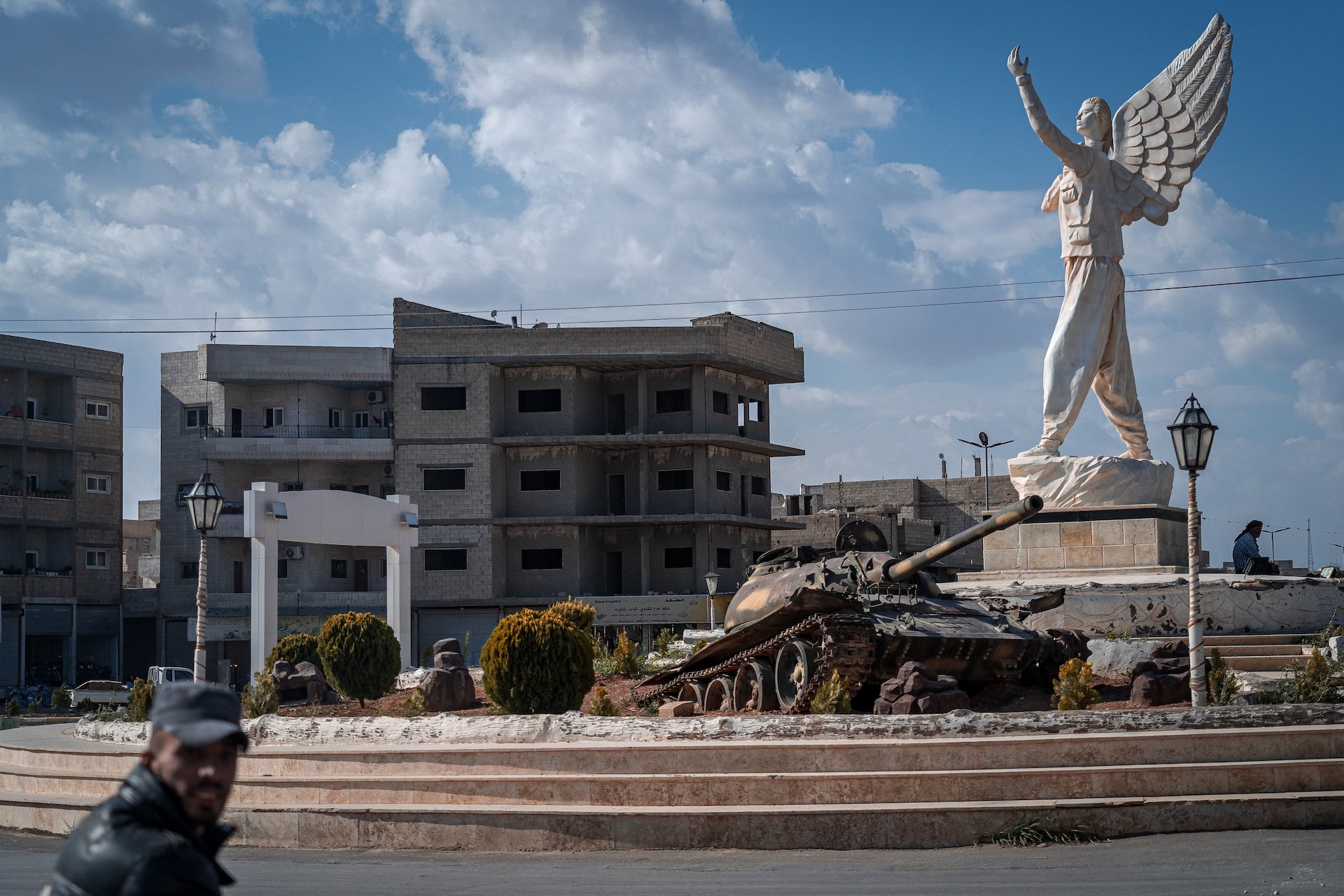
A destroyed ISIS tank stands as a war prize in a traffic circle in Kobani. American warplanes and Syrian Democratic Forces soldiers beat back the Islamic State militants here, marking the beginning and end of the so-called caliphate. Photo courtesy of Clandestine Media Group.
This, in a way, is a perfect summary of the vibe in Raqqa and the rest of Syria: Americans wanting to help, but also fucking things up in their helping. Abu Omar said as much himself, in a diplomatic way, when we left him an hour before. I asked him if he had a message for Americans.
“You said that you came to the Middle East to build a stable democracy in the Middle East,” he told me, “but you support terror groups by supporting Turkey. You were here to help defeat ISIS, but have left us alone with a much larger threat. Why have you gone?”
The fastest way across north Syria, east to west or west to east, is the M4 highway. It runs close to the tri-border region of Iraq, Syria, and Turkey in the northeast, then bows south away from the Turkish border, crosses the Euphrates just east of Manbij, then bends southwest toward Aleppo. It’s a long straight shot across the northern third of Syria, a modern, paved, well-maintained highway at most points.
Operation Peace Spring, a 2019 Turkish offensive into northeast Syria, captured about 1,800 square miles and 600 settlements in a rough rectangle of land running from Tel Abyad to Tel Tmar, the southern border of which is the M4.
Turkish-backed militants control this ground and have a reputation for razing traffic along the M4 with mortar fire. So, instead of taking a direct route to Kobani, we drive the long, mostly dirt road around. It’s about eight hours of bouncing around, of watching out the window as the landscape changes back in reverse to the greener north that looks so much like California.
Kobani is a Kurdish city that borders Turkey and was ground zero for the only American involvement in the Syrian civil war, which took form here as the mission to stop ISIS. In September 2014, ISIS moved on Kobani after a string of victories across the Middle East. They brought captured tanks and artillery pieces from Mosul, Iraq, to besiege the city. The Kurdish forces — such as the YPG and YPJ, the People’s and Women’s Protection Units, respectively — not yet operating under the SDF umbrella at the time, partnered with the American-led coalition. After months of fighting, ISIS was stopped on Kobani’s doorstep. In the fighting, 80% of the city was destroyed, but it marked the beginning of the end for ISIS — the first time this seemingly unbeatable force rampaging across the Middle East met its maker.
Efforts to rebuild the city have stalled as funding cannot meet the needs, and there is little international support in sight.
Roshen Abdi, co-chair of the Kobani Municipal Council, tells me they outlined $1.1 million in reconstruction projects in 2022, but only a fraction was secured through the AANES. Despite the challenges of operating in a demolished city, the council also collects funds through taxes and permitting of local businesses. There is a health department that does commercial kitchen inspections, which seems something of a wonder — restaurant inspections in a bombed-out city. Get up at sunrise, and you can see some of these dollars at work in other places, too — municipal trash collectors at work, sweeping streets with hand brooms and buckets.
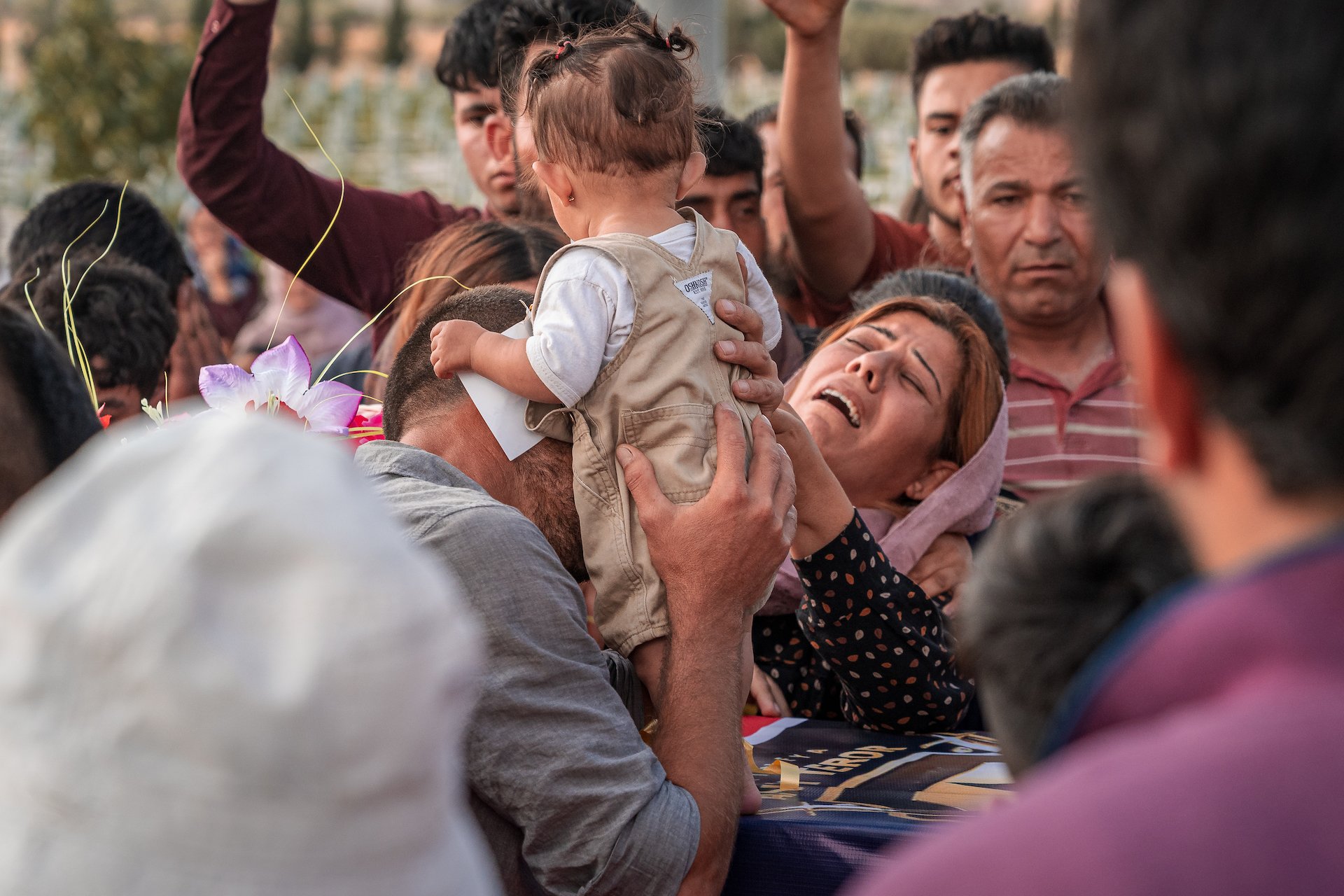
Photo by Michael R. Shea/Coffee or Die Magazine.
“The challenge is the destroyed infrastructure,” Abdi tells me. “In the past, during the Baath rule, the region was neglected. Because Kobani is a Kurdish region, it was marginalized by the Syrian regime. The war on ISIS compounded the problem.”
Funding is an issue, but so is access to machines needed to do cleanup work on a citywide scale: excavators, bulldozers, cranes. Some big machines can be brought in through the border with Kurdish Iraq to the east, and overland through Syria, but the more direct route, the nearby border with Turkey, has been closed since 2015.
With the Euphrates restricted and drought conditions taking shape, water is also fast becoming an issue, Abdi says. Then there’s the looming threat of another Turkish invasion.
In May, Turkey’s President Recep Erdoğan announced plans to invade the northern Syrian cities of Manbij and Tel Rifaat to establish a 30-kilometer “security zone” between the two countries. If this were to happen, Kobani would effectively be cut off from the rest of the AANES and greater Syria, with Turkish-occupied land to the west and the already Turkish-controlled ground north of the M4 to the east. Kobani would be a peninsula surrounded on three sides by a foreign force.
In 2016, Turkey launched Operation Euphrates Shield into northwest Syria against the SDF and secured Syrian ground along the border between Afrin and Manbij in northwest Syria. In 2018, with Operation Olive Branch, Turkey captured Afrin City.
In 2019, after then-President Donald Trump announced a withdrawal of US troops from northern Syria, Turkey invaded east of Manbij and took that 1,800-square-mile rectangle. Sitting between these two captured regions are Kobani and Manbij — flanked by Turkish-backed militant groups, including al Qaeda affiliates. Manbij is the next obvious target for Turkish forces, as it would connect their holdings to the west and east.
“The challenge is the destroyed infrastructure. In the past, during the Baath rule, the region was neglected.”
Magbula Baki, a committee leader in Kobani, sits next to Abdi in our discussion and sighs at the mention of Turkey. “The children here used to get up in the morning scared of ISIS,” she says. “Now our children are scared of the NATO member Turkey. They are scared that Turkey will use those jihadist groups to attack us once again.”
“Demographic engineering” comes up often in these meetings. It is a tactic used by dictators and despots throughout time to capture and control new territory. It boils down to essentially relocating people sympathetic to the party in power to a region that would otherwise chafe at that rule. Stalin was famous for this, as was the Ottoman Empire prior to World War I. Putin has been accused of this tactic, moving ethnic Russians to Crimea to engender support in the walk-up to the war in Ukraine.
Kurds allege this is Turkey’s aim: to capture ground in the north and east of Syria and move in Turks and Arab Muslims to the predominantly Kurdish areas to weaken any Kurdish political or military movements. In northwest Syria, this is happening in real time.
Since the Turkish push into the region, 25% of the Kurdish population, or 300,000 Kurds, have been displaced — many fleeing to AANES-controlled regions — and 400,000 Arabs have been moved in, according to the Human Rights Organization of Afrin.
Mercenaries and Islamist groups have largely done the work of disrupting the local Kurdish population. As a UN Syria Commission report noted, “After the capture of Afrin, declared in 2018 [...] a security vacuum emerged, creating a permissive environment for fighters to engage in abduction, hostage-taking, and extortion.”
The drive from Kobani to Manbij takes about an hour, on mostly good roads through the rolling hills. Manbij is a city of 1.1 million, about 70% Arab, 15% Kurd, and 15% Turkmens and other ethnic minorities. West of the Euphrates, it’s been a commercial gateway to the Middle East since the Romans ruled the region. You can see some modern signs of this from the road: a series of large agricultural and dairy plants. There is also a small pharmaceutical industry and a booming textiles trade.
After the start of the civil war, rebels took Manbij from Assad’s control in 2012, but then the city fell to ISIS in 2014, before the SDF captured it in 2016. Soon after, the SDF turned the city’s protection over to the local Manbij Military Council, a partner force under the SDF umbrella.
With Turkey threatening invasion, and US pullback from the region, alliances have shifted, and now Assad’s forces and the Russian military are present in the area, again, working with SDF and AANES officials to repel another anticipated Turkish invasion.
Muhammad Kheir, the co-chair of the Manbij Executive Council, says that while many families in the region have connections or extended family in Turkey, very few want to see the city under Turkish rule. With the AANES model, the city is finally at peace.
“As long as you are a citizen, you belong in the decision-making process, and you should have your like identity, your cultural identity, respected."
“Under the regime, and then ISIS, women as well as the diverse ethnic communities were marginalized and excluded from participation in government,” he says. “Then, after the liberation of Manbij by the Syrian Democratic Forces, the civil administration was established, with close attention paid to the participation of the diverse ethnic and religious groups here. All of them are represented. Women are included. This has led to peace here, in the streets, to build a participatory system.”
The municipality, like most others within the AANES, is organized into 12 committees to govern and regulate the workaday realities of urban life: health; finance; internal security or policing; economy; agriculture; social affairs, which works largely with internally displaced people in exile from other parts of Syria; women; education; youth and sport; foreign relations; and culture and art. Every committee is co-chaired by a man and a woman.
“As long as you are a citizen, you belong in the decision-making process, and you should have your like identity, your cultural identity, respected,” says Kheir. “So here in Manbij, we have one Armenian family living here. We asked them to bring a representative to the local parliament, to the Legislative Council, so their family can be represented in the lawmaking process.”
Under ISIS, he says, the people suffered tremendous violence. “The people were scared. ISIS committed a lot of horrific crimes, such as decapitations, and beheading people in squares. They banned jeans. Even wearing ‘Western’ jeans was banned. It was a chaotic time.”
ISIS didn’t rule so much as it operated like a loosely organized crime syndicate, with the streets divided among various sympathetic criminal gangs, says Nazifa Khalo, the female co-chair of the Manbij Executive Council.
“There were lots of problems in the streets,” she says. “Shopkeepers being robbed, looting, attacks. They were gangsters. They only cared about looting, pillaging, and collecting tax money. The fear now is Turkey invades the region with its mercenaries, then there will be all this destruction again, looting, and all kinds of these crimes again. The people are afraid it will go back, and it’s especially real now after feeling the security and stability provided by the Autonomous Administration.”
Before we visit the front of this new potential war with Turkey, an escort takes us to a house in downtown Manbij. “The media center,” he says through a translator. “For lunch.” Reports have come in of Turkey shelling random villages west of the city center. The Manbij Military Council and municipal government have evacuated most of those rural people to reduce casualties.
We sit on the floor in front of a small television running a Kurdish Iraqi news station. The television is flanked by two potted plastic plants — black roses, unironically — and an SDF flag. A middle-aged man in bluejeans with a two-tone gold Rolex sits with us. He smokes and makes calls, rarely looking up from his phone. One of the soldiers shows us his phone with a video on it of a crowd throwing rocks at a police checkpoint. He says it’s a protest near Afrin after a military leader raped a local girl, but we can’t tell for sure. He shows us another video of a mortar round sending up a dust cloud in the distance.

Photo by Michael R. Shea/Coffee or Die Magazine.
“Today,” he says.
“Here?” I ask.
“Just west of here.”
To get cleared to visit the front, we meet with Muhammad Abu Adel, chair of the Manbij Military Council, head of the region’s defense. “Manbij was liberated from the Syrian regime on the 19th of July 2012 without fighting,” he tells me. “In the beginning, the fight was between the Free Syrian Army and the Syrian regime in general.”
By Abu Adel’s account, money flooded into Free Syrian Army coffers as players from around the world raced to fund the rebels who aimed to take down Assad. But that money fractured the organization, corrupted the army, and it devolved into, in his words, “well-funded gangs.” Until the battle of Kobani, Abu Adel says that Turkey was his largest funding source.
“Turkey told us we should withdraw from Kobani and not fight with the Kurds, otherwise, we will stop funding you,” he says. “We didn’t listen to Turkey. We fought in Kobani against ISIS. We joined the coalition.”
Asked about the current threat from Turkey, the word Abu Adel uses, again and again, is “betrayal.” He’s quick to say it’s not an official position, that it’s his personal opinion. But the US has not stepped in to call off Turkey in defense of its allies in the long war on ISIS. He can’t understand it.
“Why do you think the US has backed down?” I ask him.
“Ask Trump!”
“That simple?”
“Look,” he says. “Does the US support a stable democracy in the Middle East, or does it not? It does not have to be complicated. Turkey wants to make it complicated. The US can do whatever it wants. It should do what’s right. What it has said. We are their best hope here.”
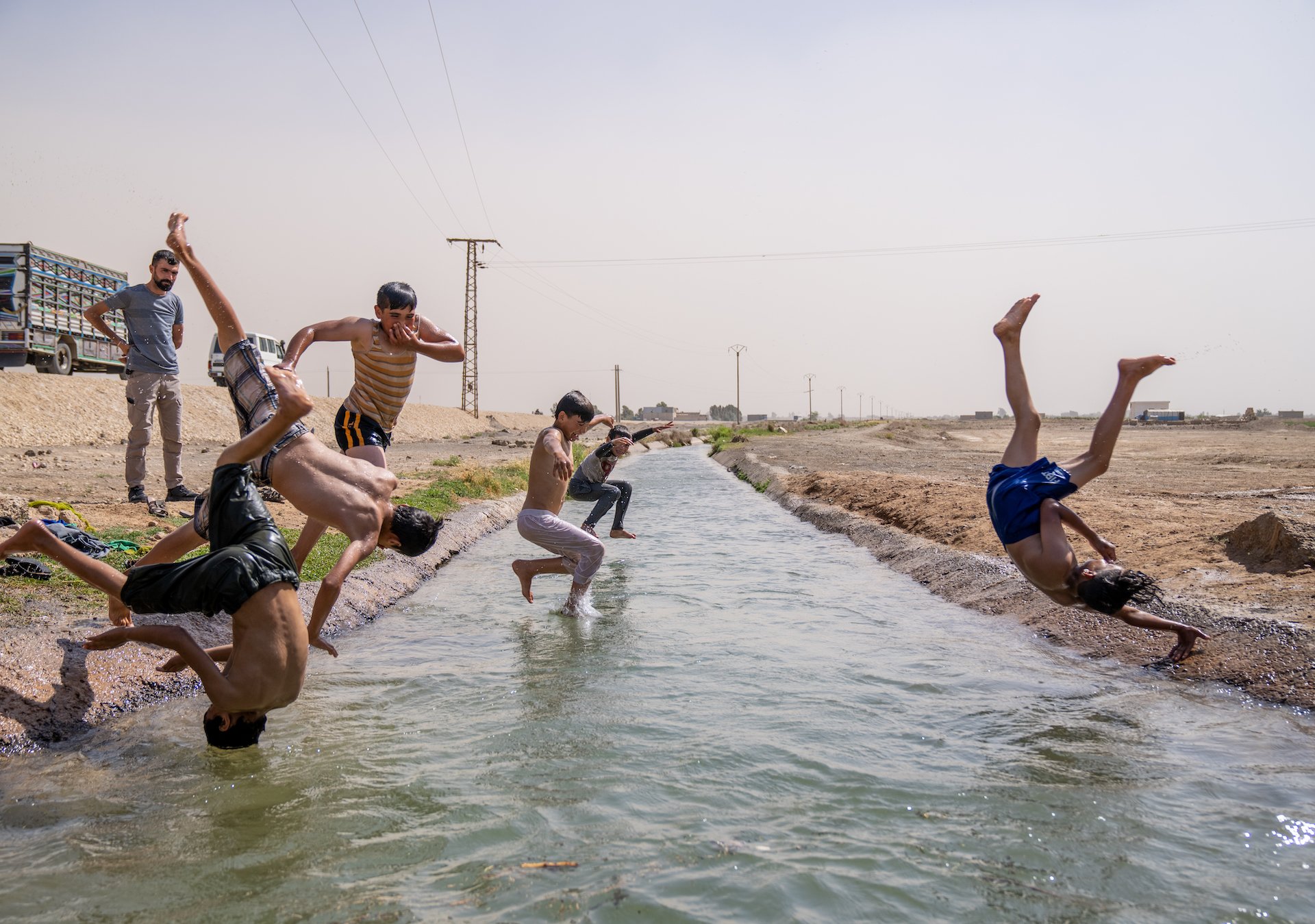
Photo courtesy of Clandestine Media Group.
Operation Inherent Resolve has avoided the Turkey question. It is singularly focused on eliminating radical Islamic terror. It is working, too, but one detail that doesn’t get reported is that every single high-level ISIS leader America has captured or killed in Syria has been found living and working in Turkish-controlled regions. But US military leaders on the ground know where ISIS and other terror groups are incubating. For example, Abu Bakr al-Baghdadi, first caliph of the Islamic State group, was found in Idlib just a few miles from the Turkish border in 2019, before detonating himself and two children with a suicide vest.
This is the argument many affiliated with the AANES make on the ground in Syria: to let Turkey invade is to allow new territory where terrorism can flourish.
Soldiers we later speak to on the front line echo this.
“Now, the region and the people are safe,” one soldier tells me. “You can go from here to Qamishli. It is safe. There is an organization, there is order, there is a system in place, but in the regions under the Turkish occupation, it’s chaos. It’s infighting between the different [military] factions, lack of security, lack of order.”
We’re not there long before we hear a screech in the sky overhead. Everyone looks up, expecting a Turkish drone. It’s an F-16.
“Time to go,” our driver says.
I agree. “Time to go.”
This article first appeared in the Fall 2022 print edition of Coffee or Die Magazine as “Finding Freedom.”
Read Next: Russia Strikes Kyiv With Iranian-Made Kamikaze Drones
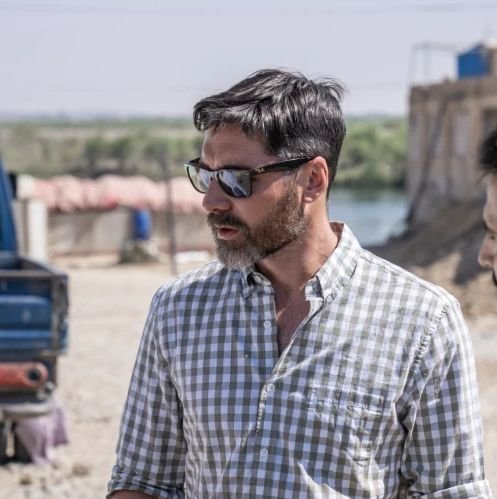
Shea is the senior editor at Free Range American, plus an itinerant freelancer for USA Today and Men’s Journal, among others. In July 2021, Gun Digest published his first book, Rimfire Revolution: A Complete Guide to Modern .22 Rifles. He holds an MFA in nonfiction writing from Columbia University. He once tanned a deer hide in an apartment bathroom. His wife was not pleased.
BRCC and Bad Moon Print Press team up for an exclusive, limited-edition T-shirt design!
BRCC partners with Team Room Design for an exclusive T-shirt release!
Thirty Seconds Out has partnered with BRCC for an exclusive shirt design invoking the God of Winter.
Lucas O'Hara of Grizzly Forge has teamed up with BRCC for a badass, exclusive Shirt Club T-shirt design featuring his most popular knife and tiomahawk.
Coffee or Die sits down with one of the graphic designers behind Black Rifle Coffee's signature look and vibe.
Biden will award the Medal of Honor to a Vietnam War Army helicopter pilot who risked his life to save a reconnaissance team from almost certain death.
Ever wonder how much Jack Mandaville would f*ck sh*t up if he went back in time? The American Revolution didn't even see him coming.
A nearly 200-year-old West Point time capsule that at first appeared to yield little more than dust contains hidden treasure, the US Military Academy said.












